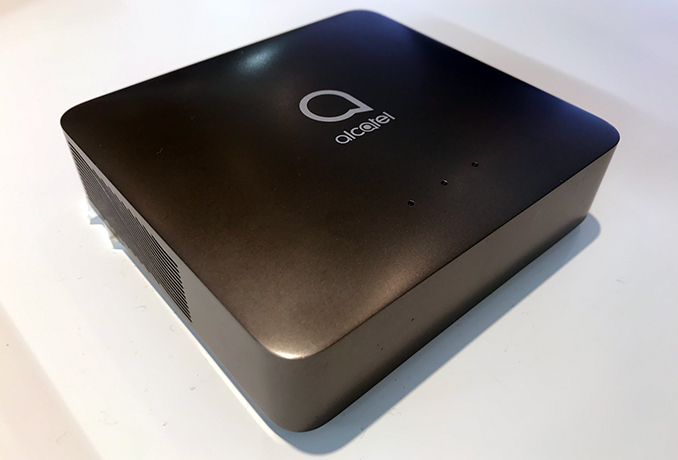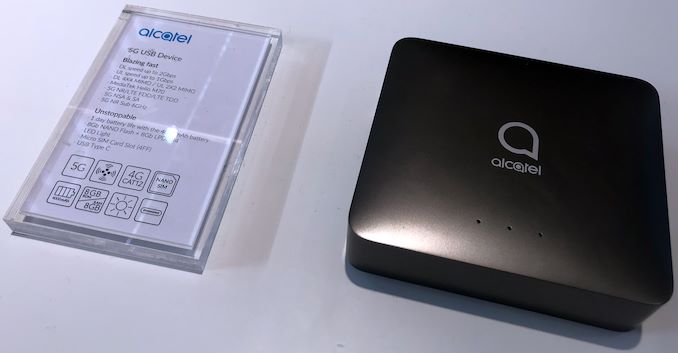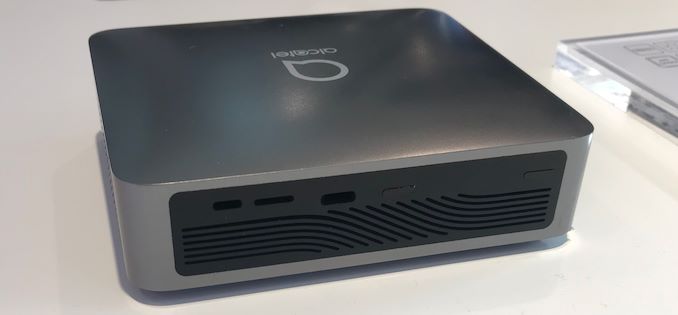Alcatel Readies a 5G Mi-Fi Hotspot with USB-C (and no Wi-Fi?)
by Anton Shilov on March 8, 2019 1:00 PM EST
One of the major use cases driving 5G development and deployment is the need for high-speed Internet connectivity in locations where it is impossible (or expensive) to cover the last mile via cables. Both carriers and hardware makers, in turn, are looking to capitalize on this by offering service contracts and high-end 5G mobile hotspots. TCL, the company behind Alcatel and BlackBerry smartphones, is prepping a rather interesting device: a 5G Mi-Fi, a 5G hotspot with a USB Type-C interface.
The Alcatel "5G USB Device" (which will likely go by other names when distributed by the carriers) supports download speeds of up to 2 Gbps (using 4x4 MIMO) and upload speeds of up to 1 Gbps (using 2x2 MIMO). The hotspot is based on MediaTek’s Helio M70 modem, which supports 5G NR/LTE and 5G NSA & SA on the sub-6 GHz band. So the hotspot won't have access to mmWave and the even higher bandwidths that provides, but sub-6 is better suited for the kind of last-mile deployments that rural 5G will be aimed at anyhow. The unit has 1 GB of LPDDR4 memory, 1 GB of NAND flash storage, and a 4000-mAh battery that can last for one day, according to the manufacturer.
One of the odd things about Alcatel’s 5G Mi-Fi is the fact that TCL does not explicitly list it as supporting Wi-Fi (at least not on its present form). Instead its only client connectivity is a USB Type-C port, which seems to be used for power as well. There are of course other wired Mi-Fi devices on the market, but it's unusual for these devices to ship with large internal batteries, as is the case for Alcatel's device. So I'm going to be surprised if we actually see the device ship without Wi-Fi support. Otherwise, expect to see the device used with solo PCs and with routers that support USB cellular adapters, the latter of which is actually a fairly common feature despite its limited use.
At the moment TCL is not saying when it plans to release its device commercially. Like so many other 5G client devices, we expect to see it launch once the 5G networks are deployed.
Related Reading:













7 Comments
View All Comments
NICOXIS - Friday, March 8, 2019 - link
I don't really understand, this is a last mile deployment that would only be able to serve one device??ksec - Friday, March 8, 2019 - link
Same question as well. It would have made a lot more sense if it had either WiFi or Gigabit Ethernet. But only USB-C seems strange. What sort of application was it intended for?Ryan Smith - Friday, March 8, 2019 - link
There are numerous routers with USB ports specifically so that they can be used with devices like these. So it can be used to service multiple devices.ikjadoon - Friday, March 8, 2019 - link
But...not many 2.4GHz client devices. USB 3.0 interferes with 2.4GHz WiFi signals.https://www.intel.com/content/www/us/en/io/univers...
My Synology RT2600ac lets me degrade the USB 3.0 port to 2.0 to reduce interference, esp. w/ 3G/4G dongles...but for a 5G device, feel like I'd be throwing the baby out with the bathwater.
At least an Ethernet option would've been nice, but I guess a female/male USB-C + a type-C Ethernet NIC wouldn't cost much.
ksec - Saturday, March 9, 2019 - link
Yes, basically those USB 4G Sticks... except this one is massive in size. And has battery built in. Normally we have battery for WiFi Hotpot so you can use it on the go, but this isn't really the size of on the go Router and does not have WiFi.If it was really intended as a simple USB 5G Modem, I wonder why they had it this big. ( Or it could merely be the Photo making it look big )
Sttm - Monday, March 11, 2019 - link
Great point about the size, if you look at the usb-c port and picture your phone above it, it doesn't seem that big.Estyle - Saturday, July 20, 2019 - link
Check more details specifications here: https://www.4gltemall.com/alcatel-5g-mobile-hotspo...